
9. Complementary lines of argument (NTB 24-10)
Aims of the chapter:
- To describe natural and archaeological analogues that enhance confidence in phenomenological process understanding.
- To present complementary safety indicators to provide additional insights into the evolution of the hazard potential of the waste and its radiotoxicity.
- To show that numerous conservative assumptions and simplifications are incorporated in the models used to estimate the dose.
The safety margins, in terms of dose, calculated in the analysis of radiological consequences, are a key line of argument for the safety of the repository system. Other complementary lines of argument are presented in this chapter.
These consist of:
-
Natural and archaeological analogues
Section 9.1 discusses studies of natural and archaeological analogues of features present, or processes occurring, within the repository system. These enhance confidence that the engineered and geological barriers are physically and chemically stable, at least to the extent assumed in safety assessment, and that all relevant processes are considered in the safety assessment models. Natural and archaeological analogues can be identified that are relevant to the geological barrier, to the engineered barriers and to key interfaces between the barriers.
-
Complementary safety and performance indicators
Section 9.2 discusses how safety and performance indicators complementary to dose and risk can be defined that provide additional insights into the evolution of the hazard potential of the waste, how radiotoxicity (a measure of this hazard potential) is distributed within the repository barrier system and how it diminishes over time due to radioactive decay, and how the flux and concentration of radiotoxicity compare with natural, as well as man-made, radiotoxicity fluxes and concentrations.
-
Conservatism of the calculated radiotoxicity and radiological consequences
The models used to calculate doses in the analysis of radiological consequences, as well as to evaluate radiotoxicity fluxes and concentrations, incorporate numerous conservative assumptions and simplifications, as summarised in Section 9.3, to handle uncertainties that are not addressed by other means (e.g., through parameter variations). The existence of these conservatisms means that doses, radiotoxicity fluxes and concentrations are generally overestimated and thus constitute another complementary line of safety-related arguments.
Incorporating natural and archaeological analogues as additional lines of argument within a safety assessment aligns with IAEA’s guidelines for post-closure safety assessments for radioactive waste repositories. Following, e.g., Côme & Chapman (1986) and IAEA (1999), these analogues can be defined as natural or man-made environments and/or materials that share common features or similarities with, and thus can provide useful information on, the repository system and its evolution over time. They allow processes and their effects to be observed on large temporal and spatial scales, similar to, or even exceeding, those relevant to safety assessment, providing insights into the durability of system components and into the effective isolation of radioactive materials in a repository. They can showcase the resilience of chosen barrier materials to potentially detrimental repository induced effects and to long-term degradation processes.
Analogues can usefully complement site-specific information, especially at the early stages of a programme where such information is limited. The three-stage Sectoral Plan for Deep Geological Repositories (SGT) in Switzerland has, since 2008 (BFE 2008), led to extensive exploration and studies of potentially suitable geological environments, yielding large amounts of geological and hydrological data, as well as experimental results elucidating the behaviour of relevant materials, including radionuclides, in such environments. Nonetheless, while this reduces reliance on natural and archaeological analogues to support the durability and performance of the repository barriers, information from analogues remains integral to the post-closure safety case and is summarised in the following sections.
In most deposits and landfills both above and below ground, clay and clay barriers are used to prevent or mitigate waste seepage and contamination. It is therefore unsurprising that clays, such as bentonite and clay rocks, are considered worldwide as host rocks and/or engineered barriers for geological repositories. Clay rocks, known for their low hydraulic conductivity and high radionuclide retention capacity, are, for example, being considered as potential host rocks, not only in Switzerland, but also in Belgium, Canada and France. As a specific example, in the proposed concept for a deep geological repository at Bure, France, the 130-metre-thick clay-rich unit of the Callovian-Oxfordian argillite formation, serves as a substantial natural barrier against radionuclide release to the surface (Andra 2022).
Clay rocks such as the Opalinus Clay have proven to provide robust transport barriers, or seals, in many different environments. Numerous examples exist in the oil and gas industry where clay-based seals have demonstrably and comprehensively been used to prevent oil and gas transport over timescales of thousands to millions of years. These seals not only confine fluids beneath them, but also within them, as evident from the many clay formations that produce oil and gas around the globe. Examples are the Duvernay and Canol Formations in Canada (Biddle et al. 2021, Lee et al. 2019), the Eagle Ford Shale in the USA (Speight 2020), and the Vaca Muerta Formation in Argentina (Casala et al. 2019). These clay formations are often overpressured due to in-situ oil and gas generation during burial by in-situ thermal maturation of the original organic matter, consistent with their low permeability. The effectiveness of clay formations as long-term seals has been demonstrated for various deep (often 1,000 m) oil and gas reservoirs, including cap rocks for CO2 disposal sites, even in the presence of significant tectonic faults. This suggests that clay formations, even when faulted, do not serve as major long-term conduits for flow due to their ductility and inherent ability to self-seal (Zhu et al. 2013). A comprehensive discussion and analysis of selected aspects of clay-based barrier performance in petroleum systems can be found in the work of Fisher et al. (2023).
Because of these properties, clay formations are frequently regarded as ideal cap rocks for shallow storage or for oil and gas reservoirs. Extensive exploration in oil-sand regions such as Venezuela and Canada have focused on understanding the thermo-hydro-mechanical behaviour of clay formations. Interbedded clay-rich units within sandy reservoirs can also act as discrete barriers to transport, influencing recovery performance due to their low permeabilities (Kumar & Hassanzadeh 2021, Gao et al. 2022).
Evidence from around the globe of slow diffusion-dominated transport in shales is complemented by a large body of isotope exchange (Aschwanden et al. 2024) and diffusion studies (Van Loon et al. 2023, Glaus et al. 2024b) from Northern Switzerland, particularly on Opalinus Clay (see Section 4.6 of NTB 24‑17, Nagra 2024i). The studies reveal prolonged porewater residence times and slow diffusion-dominated transport of solutes in the Opalinus Clay, where the repository will be located, in the overlying and underlying confining geological units and towards the bounding aquifers. Consistent aqueous concentration profiles of natural tracer profiles (Fig. 9‑1) suggest low hydraulic conductivity and minimal hydraulic gradients. Moreover, tracer profiles are not noticeably affected by the contrasting properties of the limestone-rich beds of the «Herrenwis Unit» of the upper confining geological units, which represent a regional reef mount (Nagra 2024i). The clays also exhibit a high sorption capacity (Marques Fernandes et al. 2024b).
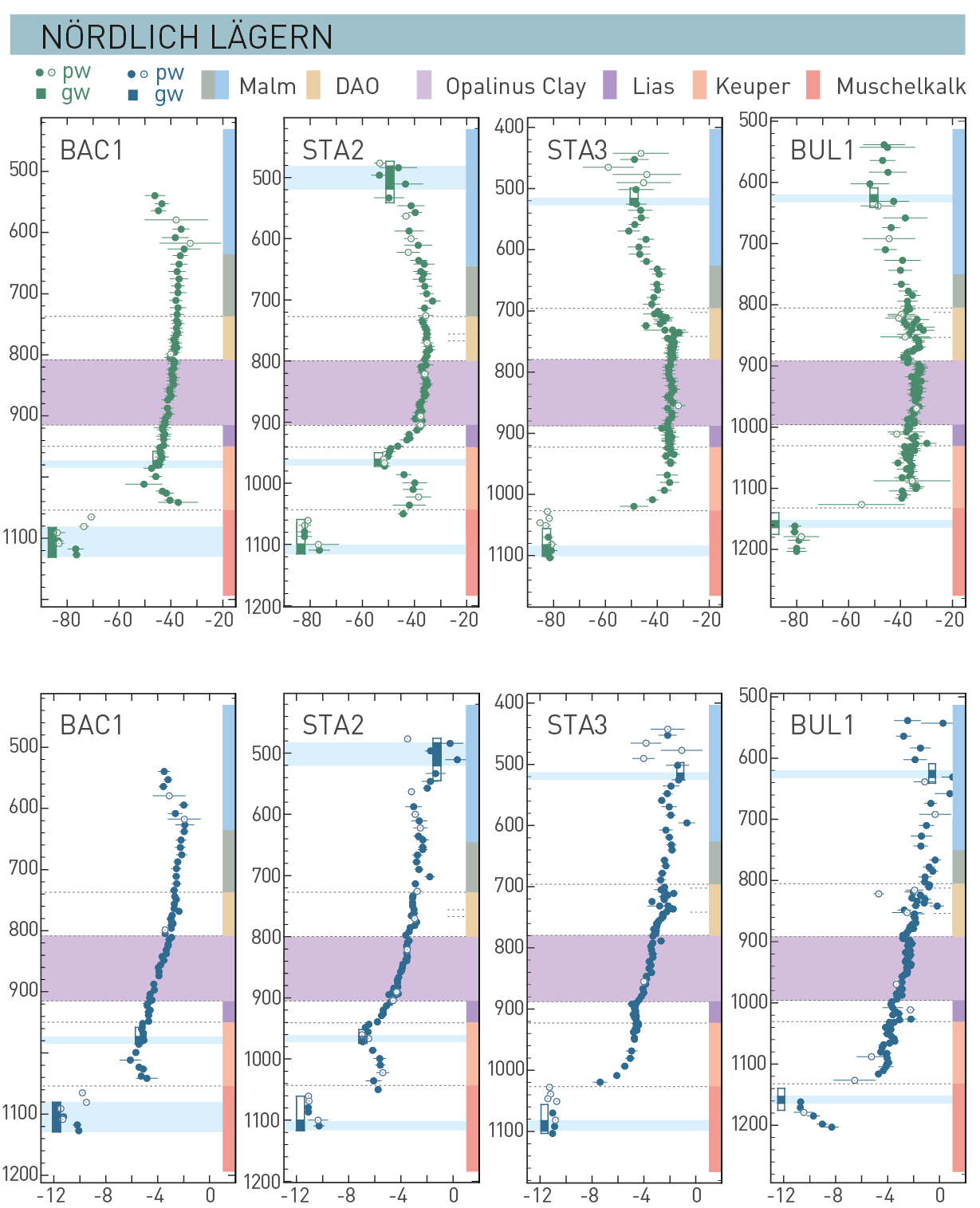
Fig. 9‑1:Profiles of d2H [‰ VSMOW] (top row) and δ18O [‰ VSMOW] (bottom row) in porewater (pw) and groundwater (gw).
In general, the porewater profile within the Opalinus Clay (purple band in the background) down to the lower part of the Keuper is linear, whereas the profile in STA2 is characterised by a clearly curved profile or profile parts especially towards the top of the Keuper. The steep drop towards the aquifers show that the original porewater within the clay rock experienced little exchange with modern meteoric water (simplified from Figure 4-119 of NTB 24-17, Nagra 2024i). Porewater data were derived from diffusive isotope exchange experiments; open symbols: less reliable (potential artefacts or contamination with drilling fluid). Where groundwater could be sampled, open rectangles show packer intervals, closed rectangles and light blue bands in the background most likely inflow zones. DAO: Dogger Group above Opalinus Clay. Light blue background indicates the location of aquifers.
Spent fuel
Several natural analogues for SF have been extensively studied since the late 1960s to obtain more information and data on the resistance of such material to oxidation and on degradation under natural, repository-relevant conditions. The best SF analogues are sedimentary uranium ore deposits formed under reducing conditions, as indicated in Chapter 6 of NAB 23-10 (Johnson et al. 2023). Examples include a range of uranium ore bodies such as El Berrocal in Spain, Poços de Caldas in Brazil, Oklo in Gabon, Koongarra in Australia, Cigar Lake in Canada and the Witwatersrand Au-U placer deposit in South Africa (Armstrong 1981). Researchers have explored these analogues to investigate in detail various different processes influencing the long-term behaviour of spent fuel (Smellie & Karlsson 1999, Smellie et al. 1997, West et al. 1992). According to Milodowski et al. (2015), naturally occurring uranium minerals such as uranite and, to a lesser extent, pitchblende, serve as excellent analogues for SF.
In the study of the Cigar Lake ore body in Canada, Smellie & Karlsson (1996) addressed important questions regarding radiolysis, fuel dissolution, and redox fronts (Section 6.4 in NAB 23-10, Johnson et al. 2023). They found that the ore body had remained essentially unchanged since its formation over 1,300 million years ago, thus supporting the long-term stability of SF. The most notable result is the evidence of UO2 resistance against radiolytic oxidation. In particular, the Cigar Lake uranite ore maintained its predominately reduced state despite undergoing significant alpha radiolysis and experiencing prolonged hydrothermal activity spanning millions of years. Bruno & Spahiu (2014) concluded, based on a subsequent reanalysis of the original Cigar Lake data, that “the long-term stability of the UO2 matrix is warranted by the recombination of the radiolytically generated oxidants and reductants”.
In the Oklo natural reactor in Gabon (Francewill Basin), uranium ore is mainly composed of UO2 in direct contact with organic matter, filling the porosity of the sandstone (Section 6.5 in NAB 23-10, Johnson et al. 2023). Isotopic signatures indicated that criticality has occurred and was reached in regions of highest uranium enrichment and porosity. Within the reactor zones (which represent the fuel analogues) UO2 remains the dominating phase (Gauthier-Lafaye et al. 1996). The environmental conditions remained reducing throughout the history of the reactor, due to the large amounts of associated hydrocarbons. In the analogy with the high-level waste near field, the organic matter takes the “chemical role” of the metallic canister. Despite its complex tectonic and hydrothermal history, UO2 has been mostly preserved over 2,000 million years. This serves as evidence that extensive radiolytic oxidation of UO2, resulting in massive UO2 dissolution and reprecipitation as U(VI), did not occur (Johnson et al. 2023). The identification of H2‑rich fluid inclusions (along with O-rich fluid inclusions, Dubessy et al. 1988) could be interpreted as the product of water radiolysis. The coexistence of these fluid inclusions with the well-preserved uraninite suggests that the radiolytically produced H2 was chemically activated, providing protection against the oxidation of UO2.
The study of Johnson et al. (2023) concluded in Section 7.2 that “The low fractional dissolution rates recommended to be used in safety assessment are based on multiple arguments, including natural analogue studies showing that uraninite remains stable over geologic time frames.”
Hence, natural analogues complement the data derived from laboratory experiments, offering insights into spent fuel dissolution over geological timescales. However, it is important to acknowledge the limitations of the analogies, given the inherent differences in environmental conditions between the geological environment of the analogies and that of a deep geological repository (Section 7.2 of NAB 23-10, Johnson et al. 2023).
Reprocessed high-level waste
For over six decades, starting with Marshall 1961, natural glasses, such as volcanic glass and tektites, as well as archaeological glasses, such as uranium-bearing drinking vessels, slag or glass blocks of Roman age, have been the subject of extensive studies as analogues for reprocessed (vitrified) high-level waste. The primary focus has been on determining dissolution processes and rates, along with identifying the characteristics of secondary alteration products (see Miller et al. 2000 for specific examples).
Among these glasses, basaltic glasses exhibit the highest resemblance to contemporary RP-HLW formulations and are generally acknowledged as the most suitable analogues for borosilicate HLW glasses (Havlova et al. 2008). Due to the absence of high B2O3 in these glasses and radionuclides in general (Posiva 2023) both natural and archaeological glasses are of limited use as analogues of RP-HLW. Despite this limitation, the absorption of dissolved uranium on the surface of degradation products of natural glass, as observed by MacDougall (1977), suggests that radionuclides released from RP-HLW could potentially be sequestered by analogous secondary degradation phases on the waste package. Additionally, based on the examination of 425 natural glasses, it is suggested that over half of those were 2 million years old (Ewing 1979). Such information provides confidence that rapid degradation of RP-HLW is unlikely to occur during the time period for assessment.
Studies on Roman glass blocks buried in seawater-saturated mud provide additional insights despite the limitations of this chemical analogy (Section 4.4.5.2 in NAB 23-09, Curti 2022). Peripheral regions (rims) exposed to seawater exhibit higher degradation rates compared with internal regions. The long-term behaviour of basaltic glasses is extrapolated from laboratory experiments and natural occurrences, albeit with uncertainties. Degradation rates derived from natural basalts can underestimate true rates due to unrealistic assumptions and temperature uncertainties as summarised in Section 4.4.5.2 in NAB 23-09 (Curti 2022). Even though there are undisputable large uncertainties in estimating nuclear waste glass corrosion rates from natural and archaeological analogues due to varying conditions and compositions, these studies improve qualitative understanding of glass dissolution processes.
HLW disposal canisters
Mechanical and corrosion-related degradation processes will eventually lead to the breaching of the disposal canisters, which will then no longer provide complete containment of radionuclides. Along with copper, carbon steel is one of the few candidate canister materials for which there are natural and/or archaeological analogues that can help support long-term predictions of the corrosion behaviour (King 2021, Neff et al. 2010, Alexander & Reijonen 2023).
Various types of iron analogues, including natural analogues such as native iron (though rare) and archaeological analogues such as iron artefacts, have been extensively studied in the literature. Analogue studies can be used to support canister lifetime predictions by the provision of corrosion damage data, typically in the form of either corrosion rates (e.g., Crossland 2005) or pit depths (e.g., JNC 2000), over timescales unavailable to experiments, and by supporting the development of conceptual models and the validation of mechanistically based corrosion models.
Corrosion-related analogue studies often form part of a well-structured canister development programme that combines the results from short-term laboratory experiments, simulations and modelling, large-scale in-situ tests, and analogue studies (Dillmann et al. 2014). In general, analogues are used to support predictions of the rate and extent of uniform and localised corrosion rather than environmentally assisted cracking mechanisms, for which there are few, if any, analogues (King et al. 2023, Nagra 2024d). In addition, analogue studies are not widely used to support predictions of the mechanical stability of the canister.
Bentonite buffer
In line with the current safety and repository concept, bentonite is commonly used as a buffer material in repositories for the disposal of radioactive waste (Karnland et al. 2008, Karnland et al. 2007, Smellie 2001) and thus its thermal and long-term stability is critical. Examples of the long-term chemical and mineralogical stability of bentonite include those from Saskatchewan, Canada (75 Ma Avonlea bentonite), Wyoming, USA (95 Ma MX-80 bentonite) (Keto 1999) and Kiruna, Sweden (probably in the order of hundreds of Ma to 1 Ga old bentonite, Alexander et al. 2024), all periods greatly excess those required for bentonite in engineered barriers.
Other aspects of bentonite longevity have been addressed in a range of natural analogue studies and quantitative data are available for corrosion product interaction (Alexander & Reijonen 2023), low-alkali cement leachate interaction (Milodowski et al. 2016), illitisation (Leupin et al. 2014), host rock interaction (Alexander & Reijonen 2023) and canister settling (Alexander et al. 2017). A dedicated study of the thermal alteration of bentonite has been initiated at an identified site, offering valuable data for future post-closure safety cases (Alexander & Reijonen 2023). Despite some shortcomings identified by Laine & Karttunen (2010) in natural analogues studies for bentonite applications in the framework of post-closure safety cases, there is confidence that bentonite can meet safety related requirements for at least the entire time period for assessment.
Cementitious materials
An understanding of cement durability and degradation processes is needed to assess the evolution of the cementitious near field of the L/ILW repository. Cementitious materials are considered metastable products from a thermodynamic standpoint, implying that they will undergo changes and remineralisations over time due to internal and external cement degradation processes. These processes include aggregate-concrete interaction, alkali-silica reaction, mineralogical alteration by carbonatisation, leaching, and interaction with fluids containing concentrated ions (see Section 2.2 in NTB 23-03, Kosakowski et al. 2023).
Most information on the longevity of cement phases as present in Ordinary Portland cement (OPC) has been gathered during the Maqarin Natural Analogue Project of which Nagra was a partner (see Pitty & Alexander 2011, Martin et al. 2016). The natural clinker-analogues at Maqarin, in northern Jordan, were formed by low-pressure and high thermal heating of the organic-rich biomicrite and chalk host rocks around 2 Ma26 ago, generating calcium silicate and calcium aluminate-ferrite mineral assemblages, which have similarities to clinker phases in modern OPC as summarised in Martin et al. 2016. Subsequent groundwater flow through these naturally generated clinker phases resulted in hyperalkaline fluids percolating through fractures and cracks created by tectonic fracturing of the biomicrite. This led to precipitations of cement minerals such as C-A-S-H, ettringite, thaumasite, and carbonates. The precipitations occurred mostly along the fractures which were infilled with such natural cement phases and underwent secondary alterations (see Milodowski et al. 2015, Martin et al. 2016 for details), which eventually sealed the former open fracture interfaces (see Fig. 9‑2). Dating of the system suggests the fracture-biomicrite interfaces sealed within a very short period of only a few years.
In distal regions along fractures further away from the natural clinker, diffusive exchange over sufficient time resulted in silicate dissolution and the precipitation of zeolites (or zeolite precursors) (Martin et al. 2016). Such secondary reaction phases are comparable to those produced when concrete is leached in the laboratory and in Underground research laboratory (URL) experiments (e.g., Mäder et al. 2006), clearly indicating the relevance of the analogy.
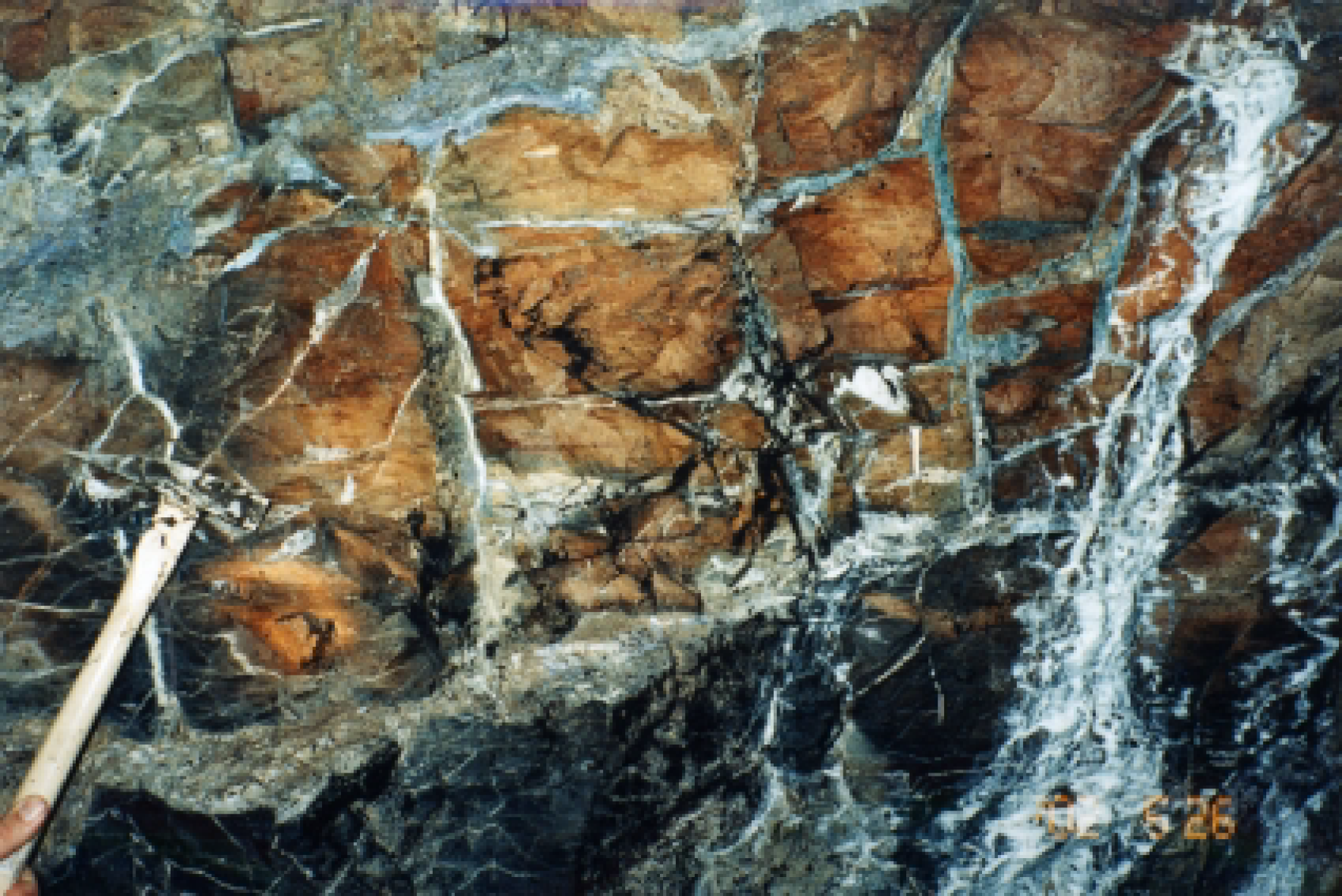
Fig. 9‑2:Heavily fractured micrite host rock with abundant sealed fractures containing a comparable product to natural concretes at the Maqarin site, Jordan
For scale, see hammer in bottom left corner (Pitty & Alexander 2011).
Even older (up to 58 million years old) natural concretes formed along similar lines have been described at Scawt Hill in Northen Ireland (Milodowski et al. 2015; 1989). ↩
Cement – clay interfaces
As in geological settings, interfaces of materials with contrasting chemical composition will evolve over time due to chemical interactions, giving rise to changes in transport properties at and across the material interfaces. In that sense, interfaces between cement and clay and the chemical interaction are of relevance, and process understanding was greatly enhanced by the CI field experiment in the Mont Terri rock laboratory, Switzerland, where cement – Opalinus clay or bentonite interactions, respectively, were investigated over several years (see Bernard et al. 2020, Yokoyama et al. 2021, Mäder et al. 2017). A detailed review on cement – clay interaction is presented in Chapter 2 of NAB 22-34 (Prasianakis et al. 2022).
Cement – clay interactions and long-term interface development have also indirectly benefited from the studies of the fractured rock complex at Maqarin, in northern Jordan, as a valuable natural analogue (see Maqarin Natural Analogue Site Study Group 1992, Linklater 1998, Alexander & Smellie 1998, Pitty & Alexander 2011 for details). There, materials around open fractures were assumed to have once been part of sealed fracture faces (Linklater 1998). Along these sealed fracture faces, mineral alterations into the limestone host rock (biomicrite) interface as a result of the hyperalkaline plume was observed to have limited penetration extent (mm) as demonstrated by Martin et al. (2016). i.e., the maximum alteration extent amounted to 25 mm. Importantly, generated interfaces where not totally clogged as e.g., an alteration rim of a vein with microscopically clogged pores was identified to contain a remaining porosity of about 19 vol.-% (Martin et al. 2016).
These observations are well aligned with what Kosakowski et al. (2023) noted in Section 3.3.2 of NTB 23-03: “Interfaces between cement and clay materials can be characterised by strong (geo)chemical differences, which influence the diffusive transport of solutes into both materials and may result in the formation of alteration fronts. Typically, dissolution of cement and clay phases is observed in combination with precipitation of secondary mineral phases at or near the material interface.” This statement derived from a synthesis and assessment of various short and long-term laboratory and URL experiments (e.g., Lalan et al. 2016, Gaboreau et al. 2020, Yokoyama et al. 2021), as well as archaeological (e.g., Lee 2001) and natural (e.g., Pitty & Alexander 2011, Martin et al. 2016) analogues.
Iron – clay interfaces
Mineralogical and chemical studies of the interfaces between clay and iron (magnetite) ore have been carried out at the Kiruna bentonite natural analogue in the Kiirunavaara mine (Alexander et al. 2024). The smectite clay is made of significant amounts of a Fe-poor montmorillonite with a generally Ca-rich exchangeable interlayer composition. Preliminary results show that magnetite ore and smectite have been in direct contact at a temperature of between 50 and 150 °C for an extended period of time (ca. 350 Ma). Little or no uptake of Fe in the clay has been observed under these conditions, which are similar to those in a deep geological repository. Thus, the observations suggest minimal to no incorporation of iron into the clay matrix. Analysis of dioctahedral smectites demonstrates only marginal fluctuations in Fe2O3 content, ranging from 0.93 to 2.46 wt.-%. Interestingly, these variations do not appear correlated with the presence or absence of residual magnetite in the altered rocks or their proximity to magnetite ores.
In addition to the calculation of the annual individual effective dose, the performance and safety of the repository system can further be illustrated using additional, complementary safety and performance indicators.
The indicators described in the following sections are based on the concept of radiotoxicity (RT) as a measure of the relative potential hazard of radioactive material. RT is defined as the effective dose received in the case of hypothetical direct ingestion of radionuclides in dissolved form into the body. RT, in units of sieverts (or millisieverts, where appropriated), is calculated from the activity Ai(t) [Bq] of a nuclide i at a time t and the ingestion dose conversion factor Fi [Sv/Bq] of the nuclide i
RT(t) = ∑i Ai(t) × Fi
RT fluxes and concentrations can be calculated in an analogous way to RT itself, by replacing the activity Ai(t) in the equation above by activity flux or activity concentration, respectively.
The consideration of these complementary indicators can provide additional arguments for safety that avoid, to some extent, the difficulties faced in evaluating and interpreting doses and risks that may occur in the far future (OECD/NEA 2004, 2012b). A comprehensive review of complementary indicators used in post-closure safety cases, including the reference values for safety indicators, is reported in (OECD/NEA 2012a).
In the following sections RT, RT fluxes and RT concentrations are used to illustrate:
-
the declining radiological hazard from the waste packages for SF, RP-HLW and L/ILW over time,
-
the evolving distribution and decay of RT in the repository barrier system, and
-
how the RT fluxes and concentrations associated with the repository system compare with other RT fluxes and concentrations in natural systems and from human activities, in order to place those associated with the repository system in perspective.
The evolution of the RT of the HLW and L/ILW disposed of in the repository is shown in Fig. 9‑3, illustrating the declining radiological hazards from the waste packages with time.
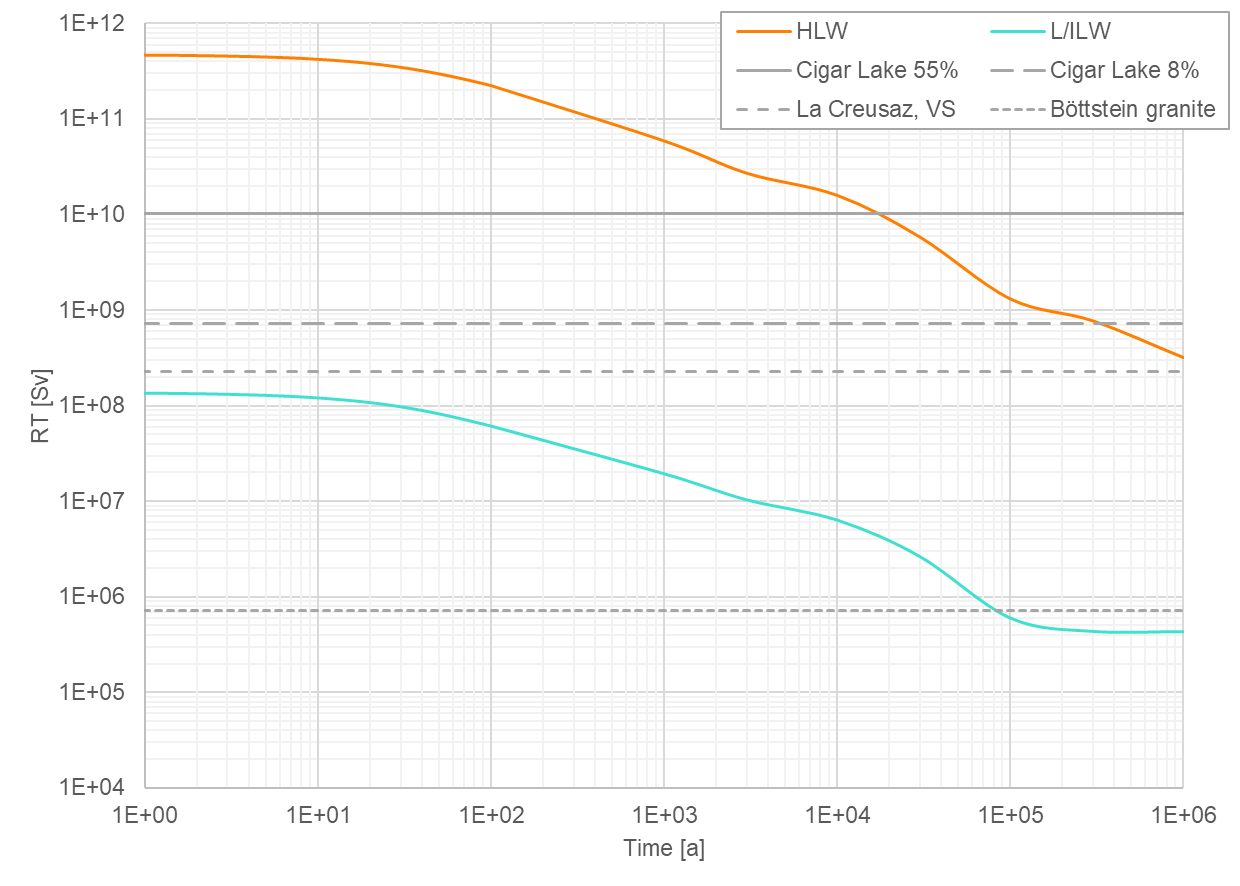
Fig. 9‑3:Evolution of the radiotoxicity (RT) of the HLW and L/ILW disposed of in the repository
The horizontal reference lines correspond to the radiotoxicity of similar volumes of rocks and ores. Note that the uranium ore lines assume the approximate volume of the HLW repository section (100,000 m3), while the granite assumes the approximate volume of the L/ILW repository section (200,000 m3) (Nagra 2024a).
Fig. 9‑3 also compares the RT of HLW and L/ILW disposed of in the repository as a function of time compared with the RTs of:
-
Böttstein granite, a well-characterised, typical granite of Northern Switzerland,
-
uranium ore from the Cigar Lake deposit in northern Saskatchewan, Canada, with two different uranium concentrations, and
-
rock from La Creusaz, a small uranium deposit in canton Valais, Switzerland,
assuming a volume of these materials roughly equal to the volumes of the emplacement drifts and caverns (see figure caption for details). The estimation of the RT of ores from Cigar Lake and La Creusaz is described in Appendix A.1 NAB 24-05 (Nagra 2024a). The estimation of the RT of Böttstein granite is described in Appendix A.2 of the same report.
After 100,000 years, the RT of the HLW has reached a level similar to that of low grade (8%) uranium ore from Cigar Lake, and, after 1 Ma, the RT is a little higher than that of the uranium-bearing rocks from La Creusaz.
The RT of L/ILW follows a similar trend to that of HLW, but with significantly lower RT values (roughly three orders of magnitude). At the time of emplacement in a deep geological repository, the radiotoxicity of the L/ILW is below that of both uranium ore from Cigar Lake and rock from the La Creusaz uranium prospect. After 100,000 years, L/ILW has a lower RT than Böttstein granite.
RT can also be used to illustrate how radiotoxicity is distributed within the repository system, how it diminishes over time due to radioactive decay, and how much reaches the biosphere. The following figures show that the great majority of the RT decays within the repository system and never reaches the surface environment.
The distribution of radiotoxicity in the various repository system barriers as a function of time in the reference case is shown in Fig. 9‑4, 9‑5, 9‑6. Key observations are:
-
SF: For times up to 106 years and beyond, the largest fraction of the radiotoxicity is contained within the fuel matrix. At 106 years, the radiotoxicity present outside the CRZ is still several orders of magnitude below that in the fuel matrix.
-
RP-HLW: For times up to a few tens of thousands of years, the largest fraction of the radiotoxicity is contained within the glass matrix. At later times, the largest fraction is sorbed in the bentonite buffer. The radiotoxicity present outside the CRZ reaches a maximum after a few million years but is still orders of magnitude below that contained within the repository barrier system.
-
L/ILW: For times up to about 105 years, the largest fraction of the radiotoxicity is sorbed in the cementitious near field, after which the largest fraction is contained within the Opalinus Clay. Radiotoxicity present outside the CRZ is too low at all times to be shown in the figure.
For comparison, as in the previous section, the RT of uranium ore from the Cigar Lake deposit in northern Saskatchewan, Canada, is also shown.
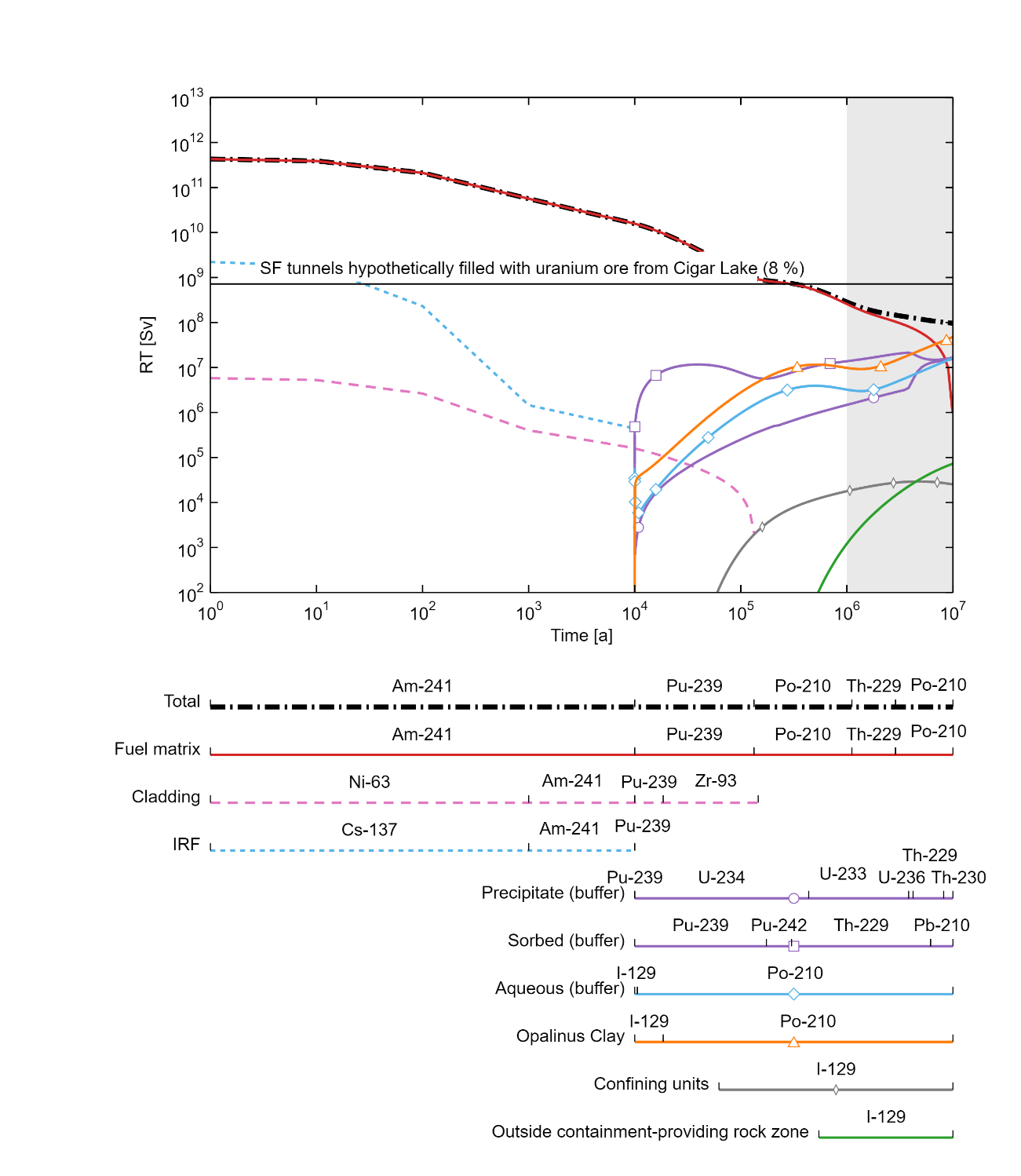
Fig. 9‑4:Evolution and distribution of radiotoxicity (RT) from SF in the different components of the repository near field, the Opalinus Clay and its confining geological units, as well as RT that exists outside the containment-providing rock zone (CRZ)
The bars beneath the graph indicate the radionuclides that make the highest contributions to RT at any given time and in any particular part of the system.
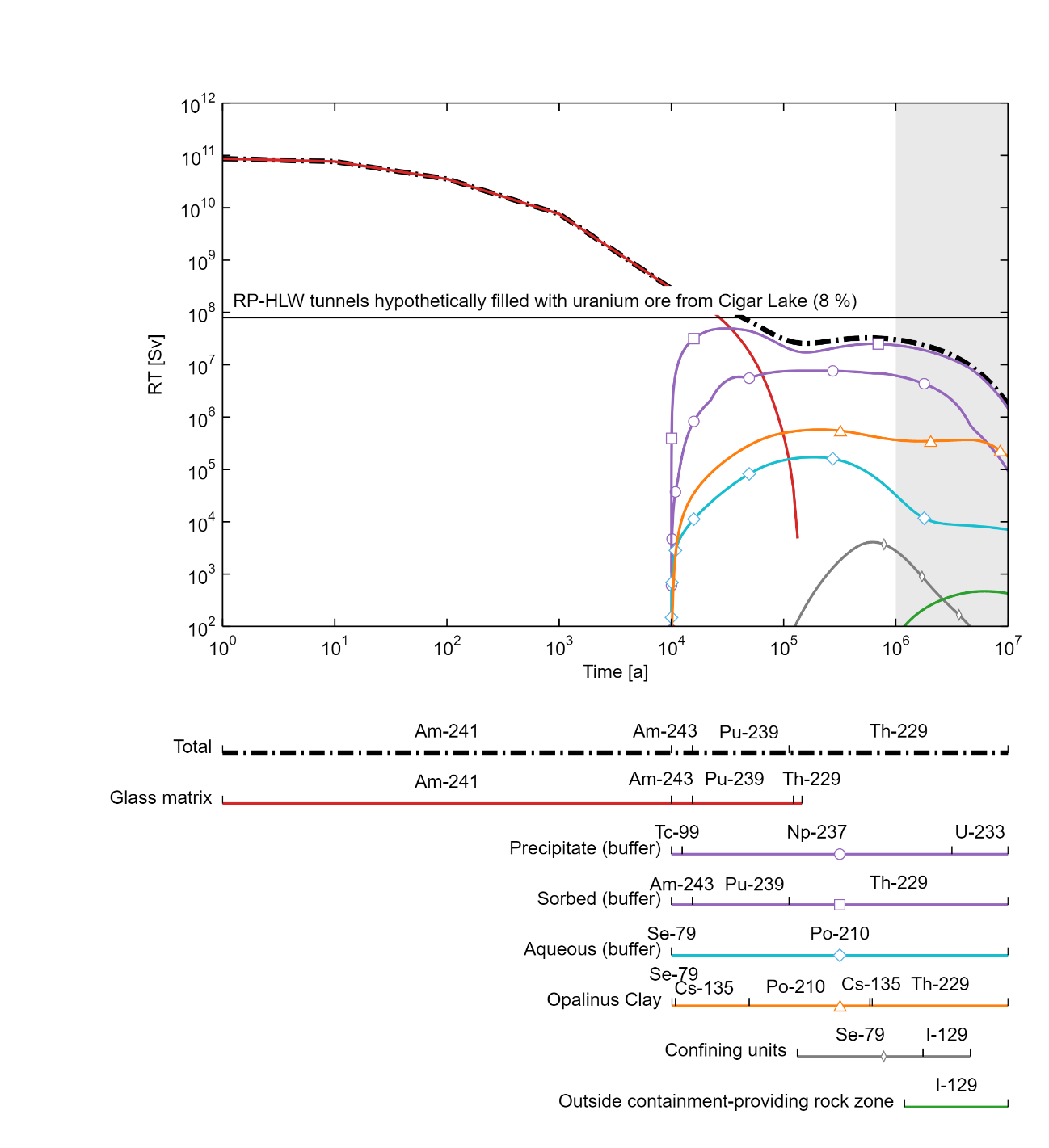
Fig. 9‑5:Evolution and distribution of radiotoxicity (RT) from RP-HLW in the different components of the repository near field, the Opalinus Clay and its confining geological units, as well as RT that exists outside the containment-providing rock zone (CRZ)
The bars beneath the graph indicate the radionuclides that make the highest contributions to RT at any given time and in any particular part of the system.
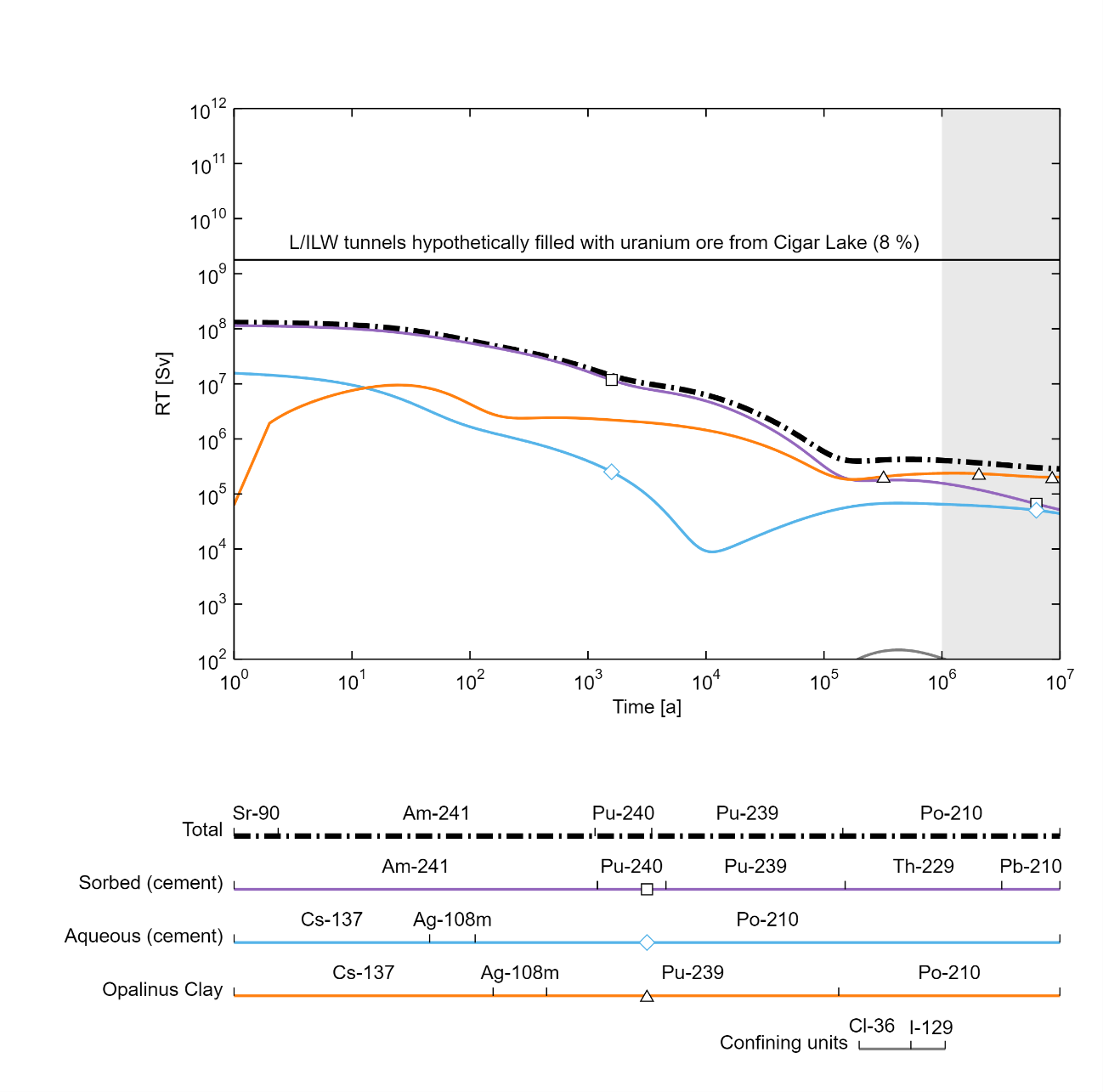
Fig. 9‑6:Evolution and distribution of radiotoxicity (RT) from L/ILW in the different components of the repository near field, the Opalinus Clay and its confining geological units, as well as RT that exists outside the containment-providing rock zone (CRZ)
The bars beneath the graph indicate the radionuclides that make the highest contributions to RT at any given time and in any particular part of the system.
Fig. 9‑7 shows the RT transfer rates, or fluxes, from the repository into the Malm aquifer above and into the Keuper and Muschelkalk aquifers below; these RT fluxes are assumed, in the analysis of radiological consequences, to be transferred directly to the biosphere. These transfer rates are compared with the following reference values, or “yardsticks”, which serve to place the transfer rates of RT from the repository in a broader perspective.
These yardsticks are based both on natural systems:
-
RT fluxes in two major rivers in Northern Switzerland, the Rhine in the vicinity of the city of Basel and the Thur,
and on human actions:
-
the RT of ash generated annually by the incineration of Swiss municipal waste.
The figure also shows the 60 Sv/a reference RT flux recommended in the EU SPIN project (Becker et al. 2002).
RT transfer rates to the biosphere via the three deep aquifers above and below the repository are orders of magnitude below all these yardsticks. They are, for example, three orders of magnitude or more below the SPIN reference value in the case of releases from HLW and five orders of magnitude or more below this reference value in the case of releases from L/ILW.
Fig. 9‑8 shows the reference case aqueous RT concentrations due to releases from the HLW canisters, with an anticipated breaching time of 10,000 years, and from L/ILW at various locations within the repository barrier system, namely:
-
the bentonite buffer, where the spatially averaged concentration is shown in the figure,
-
the L/ILW cementitious near field, where again the spatially averaged concentration is shown in the figure and
-
the lower boundary of the Opalinus Clay,
-
as well as in the Malm aquifer above the repository and in the Keuper and Muschelkalk aquifers below it.
These concentrations are compared with the RT concentrations found naturally in Swiss drinking water and in Swiss mineral water; see Tab. 9‑1 for information on these yardsticks and their sources. Fig. 9‑8 also shows the 2 × 10-5 Sv/m3 reference RT concentration recommended in the EU SPIN project, which is based on K-40, Rb-97 and actinide concentrations naturally present in surface and shallow groundwaters in Finland, Switzerland, and the Czech Republic.
Aqueous RT concentrations in both the HLW near field and the L/ILW near field remain orders of magnitude above these yardsticks for all calculated times, emphasising why the geological barrier is needed to isolate the waste from humans and the surface environment.
The dominant pathway for radionuclide transport through the Opalinus Clay in the reference case is downwards from the repository towards the Keuper aquifer; see Chapter 8 or, for more detail, Section 7.1.1.3 in NTB 24-18 (Nagra 2024p). After a few tens of thousands of years, the RT concentration due to radionuclide releases from HLW in porewater at the lower boundary of the Opalinus Clay is also above the various yardsticks, but by a much lower margin (one to three orders of magnitude) than the aqueous RT concentrations in the HLW near field. The RT concentration due to releases from L/ILW in porewater at the lower boundary of the Opalinus Clay peaks at about 200,000 years and is similar to the upper bound value for Swiss drinking water, and around an order of magnitude above the SPIN reference value.
Aqueous RT concentrations are further greatly reduced when radionuclides reach the Malm, Keuper and Muschelkalk aquifers, due to decay during transport through the confining geological units and dilution within the aquifers themselves. The aqueous RT concentration in the Malm and Keuper aquifers due to releases from HLW are within the ranges of RT concentrations found in Swiss drinking water and in Swiss mineral water. The maximum RT concentration in the Malm aquifer is about an order of magnitude above the SPIN reference value, and the maximum RT concentration in the Keuper aquifer is a little below this reference value. RT concentration in the Muschelkalk aquifer is much lower, remaining about three orders of magnitude below the SPIN reference value.
Tab. 9‑1:Descriptions, values and sources for the yardsticks presented in Fig. 9‑7 and in Fig. 9‑8
|
Yardstick |
Description/value |
Source |
|---|---|---|
|
Rhine/Thur Rivers: water + sediment |
RT flux due to radionuclides dissolved in water and due to radionuclides contained in sediments transported by the river; 3.5 × 105 Sv/a for the Rhine, 1.9 × 104 Sv/a for the Thur |
A3.5.1 in Nagra (2002) and references therein |
|
Rhine/Thur Rivers: water only |
RT flux due to radionuclides dissolved in water; 2.7 × 104 Sv/a for the Rhine, 42 Sv/a for the Thur |
|
|
Ash from municipal waste incineration |
Range of RT flux calculated for the whole of Switzerland; 4.7 × 103 Sv/a to 3.4 × 105 Sv/a |
Radiological composition of ash from municipal waste incineration based on minimum and maximum values reported in Kallio et al. (2023); per-capita waste production in Switzerland is based on the Federal Office of the Environment (available online at https://www.bfs.admin.ch/bfs/de/home/statistiken/raum-umwelt/umweltindikatoren/alle-indikatoren/emissionen-und abfaelle/siedlungsabfaelle.assetdetail.30645407.html); Size of Swiss population based on BFS (2022) |
|
Drinking water |
RT concentration in Swiss drinking water, ranging from 7.4 × 10-6 Sv/m3 to 3.4 × 10-4 Sv/m3 |
Radiological composition of drinking water based on Surbeck (2023) and on the Federal Office of Public Health (BAG 2023a) |
|
Consumption of mineral water |
RT concentration of mineral water, ranging from 1.1 × 10-5 Sv/m3 to 1.4 × 10-4 Sv/m3 |
Radiological composition of mineral water based on Baertschi (1995) |
|
SPIN reference value |
Based on several processes transferring naturally occurring radionuclides in the surface and subsurface environments, such as groundwater flow, weathering and erosion, and sediment transport, across an area of 200 km2; 60 Sv/a |
|
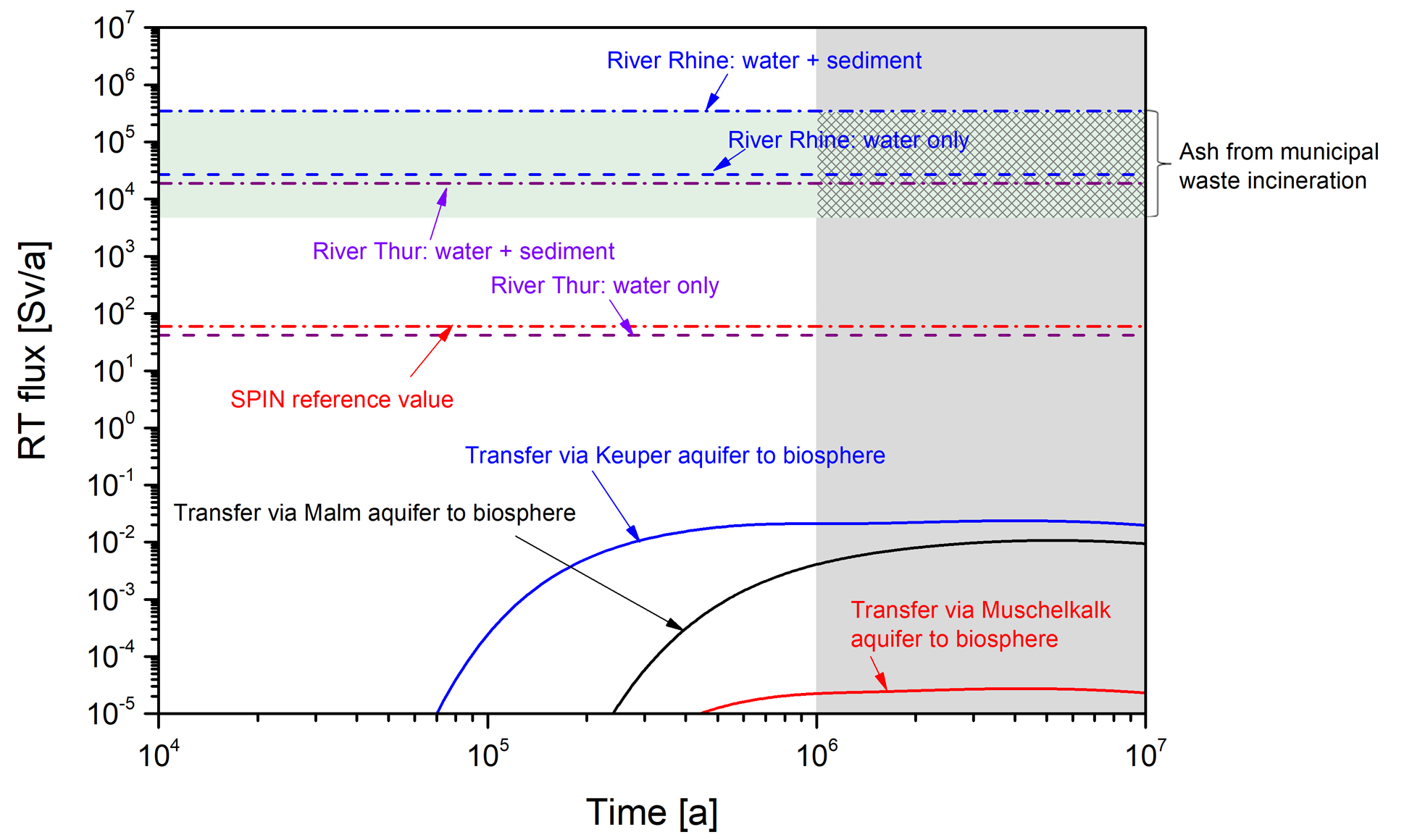
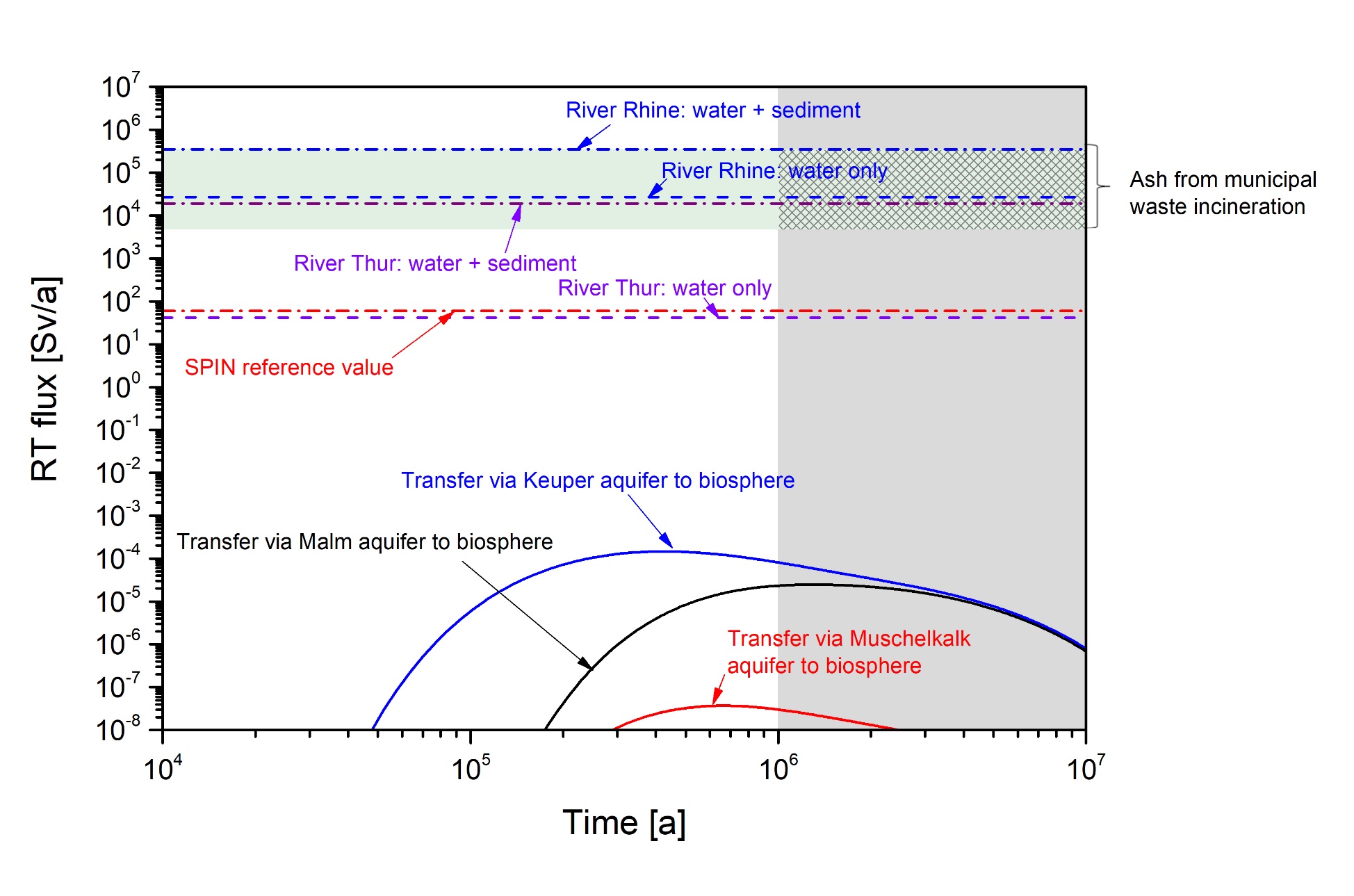
Fig. 9‑7:Reference case RT transfer rates (flux) from HLW (upper figure) and from L/ILW (lower figure) into the Malm aquifer located above the repository and into the Keuper and Muschelkalk aquifers lying below it
These fluxes are assumed, in the analysis of radiological consequences, to be further transferred directly to the biosphere. These transfer rates are compared with RT fluxes in two major rivers in Northern Switzerland, with RT fluxes from human activities, i.e., the consumption of water for drinking and the incineration of municipal waste and with a reference RT flux from the EU SPIN project.
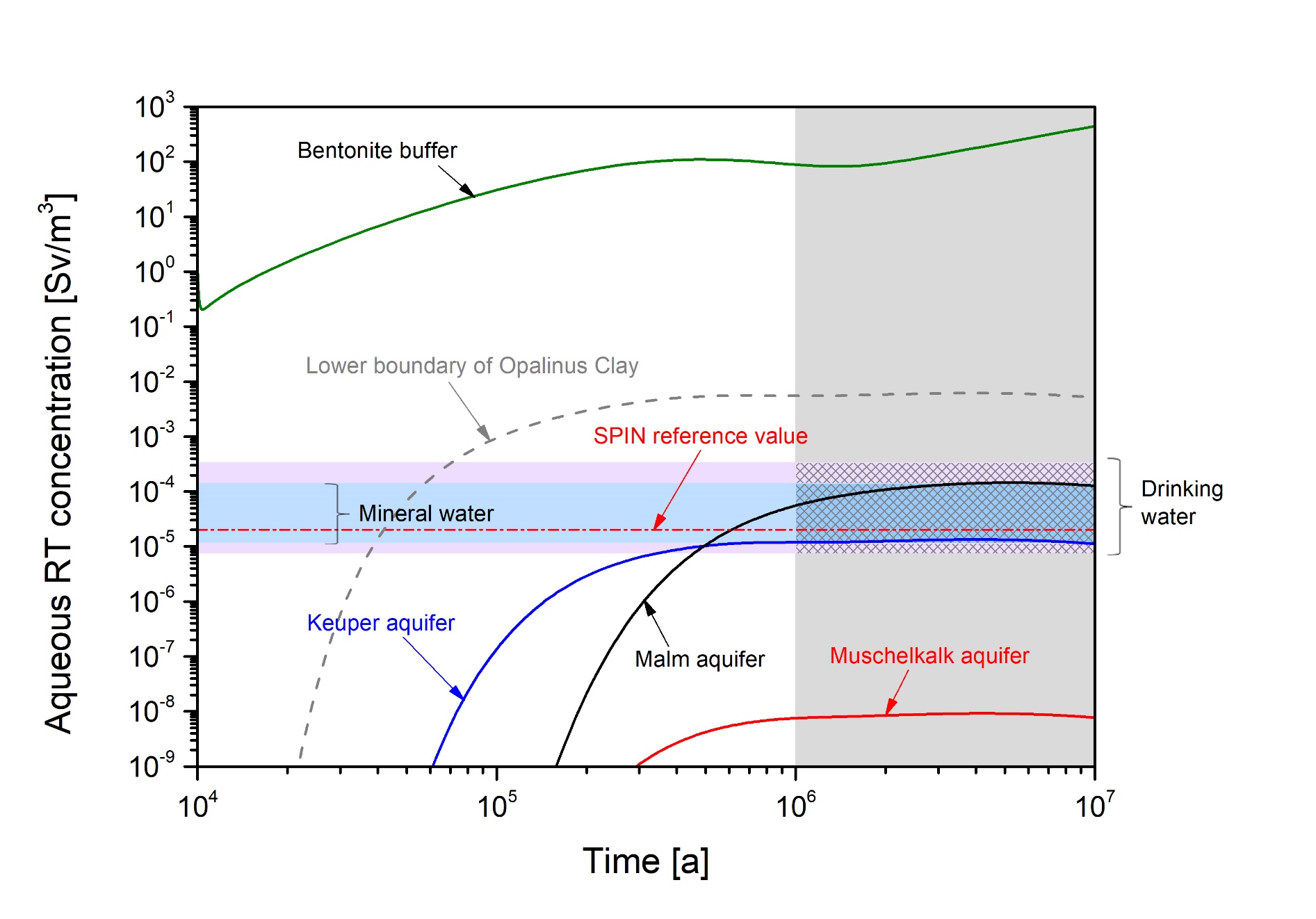
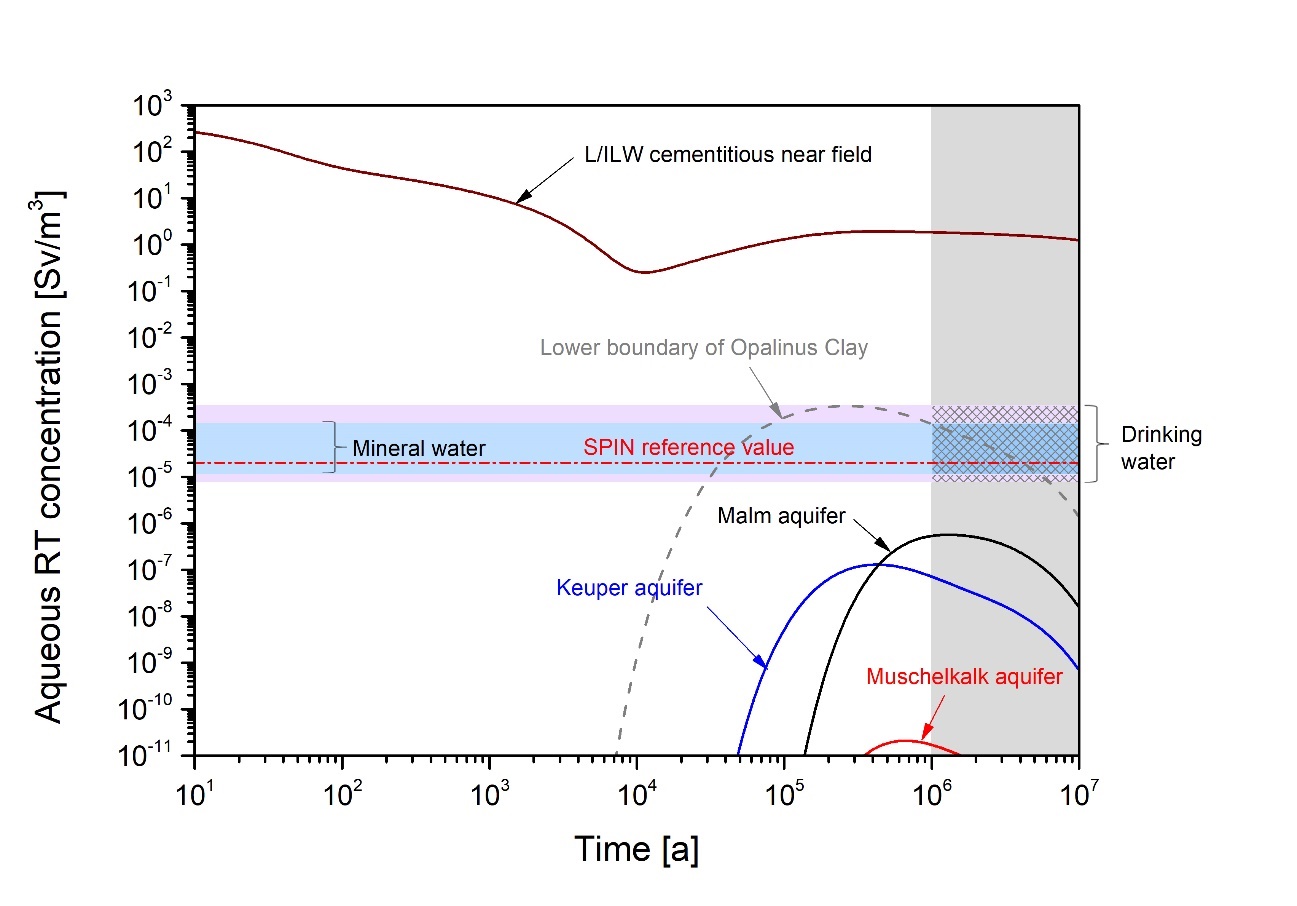
Fig. 9‑8:Reference case aqueous RT concentrations due to releases from HLW (upper figure) and from L/ILW (lower figure) at various locations within the repository barrier system, as well as in the Malm aquifer located above the repository and in the Keuper and Muschelkalk aquifers lying below it
These concentrations are compared with the RT concentrations found naturally in Swiss drinking water and in Swiss mineral water and with a reference RT concentration from the EU SPIN project. Note that the concentrations in the aquifers are obtained by dividing calculated RT fluxes from the rock to the aquifers by assumed aquifer flow rates across the repository area. These flow rates are subject to substantial uncertainty and are estimated here for illustrative purposes only.
The aqueous RT concentration in the deep aquifers due to releases from L/ILW are lower still and remain at least an order of magnitude below all the above-mentioned yardsticks.
Many radionuclides released from the repository sorb strongly on various barrier materials, retarding their transport and providing more time for radioactive decay. Fig. 9‑9 shows reference-case RT concentrations, due to both sorbed radionuclides and radionuclides present in the aqueous phase, in barrier materials within the repository system, namely:
-
the HLW bentonite buffer,
-
the L/ILW cementitious near field, and
-
the Opalinus Clay host rock.
In all three cases, spatially averaged concentrations are shown. For the Opalinus Clay host rock, this involves spatial averaging over the rock volume above and below the repository, up to the boundaries with the upper and lower confining geological units.
These concentrations are compared with the RT concentrations found naturally in various rocks, ores and average soil in Switzerland. The rock and ores used in this comparison are the same as considered in Section 9.2.1 in the context of the declining radiological hazard from the waste packages, i.e.:
-
Böttstein granite, a well-characterised, typical granite of Northern Switzerland,
-
uranium ore from the Cigar Lake deposit in northern Saskatchewan, Canada, with two different uranium concentrations, and
-
rock from La Creusaz, a small uranium deposit in canton Valais, Switzerland,
as well as the Opalinus Clay itself, as currently characterised, prior to any releases from the repository.
The RT concentrations in barrier materials within the repository system lie within the range spanned by these naturally occurring materials and are generally below the RT concentration in uranium ores.
RT concentrations in the near-field materials are generally above those found naturally in the Opalinus Clay, Böttstein granite and in Swiss soils. However, the RT concentrations in the Opalinus Clay due to releases from HLW and L/ILW are generally within the same range as found naturally in these materials. In the case of releases from HLW, the RT concentration in the Opalinus Clay increases over several millions of years, reaching a plateau value (once all the SF has degraded and released its radionuclides) that is between that of the Opalinus Clay and that of Böttstein granite. In the case of releases from L/ILW, the RT concentration in the Opalinus Clay peaks relatively rapidly, after just a few decades, at a value between that of the Opalinus Clay and the Böttstein granite, and declines gradually thereafter, reaching a value similar to that of average soil in Switzerland after about 10,000 years.
Overall, the comparisons shown in this section demonstrate that calculated RT transfer via deep aquifers to the biosphere is often much lower than the RT fluxes that currently occur in some natural systems (e.g., major rivers in Northern Switzerland), and much lower than those arising from some current human actions (waste incineration, consumption of drinking water and mineral water in Switzerland). RT concentrations, both aqueous and sorbed, are relatively high in the repository near field, but, in the host rock, they are similar to those occurring in many natural systems and materials. Furthermore, in the deep aquifer water that could potentially reach the biosphere, aqueous RT concentrations due to repository releases are well below the RT concentrations occurring in many natural systems and materials. Such comparisons can place the RT transfers due to the repository in a broader perspective, emphasising that radionuclide fluxes and concentrations that may arise due to the presence of the repository are often much lower than those that already exist in the human environment today.
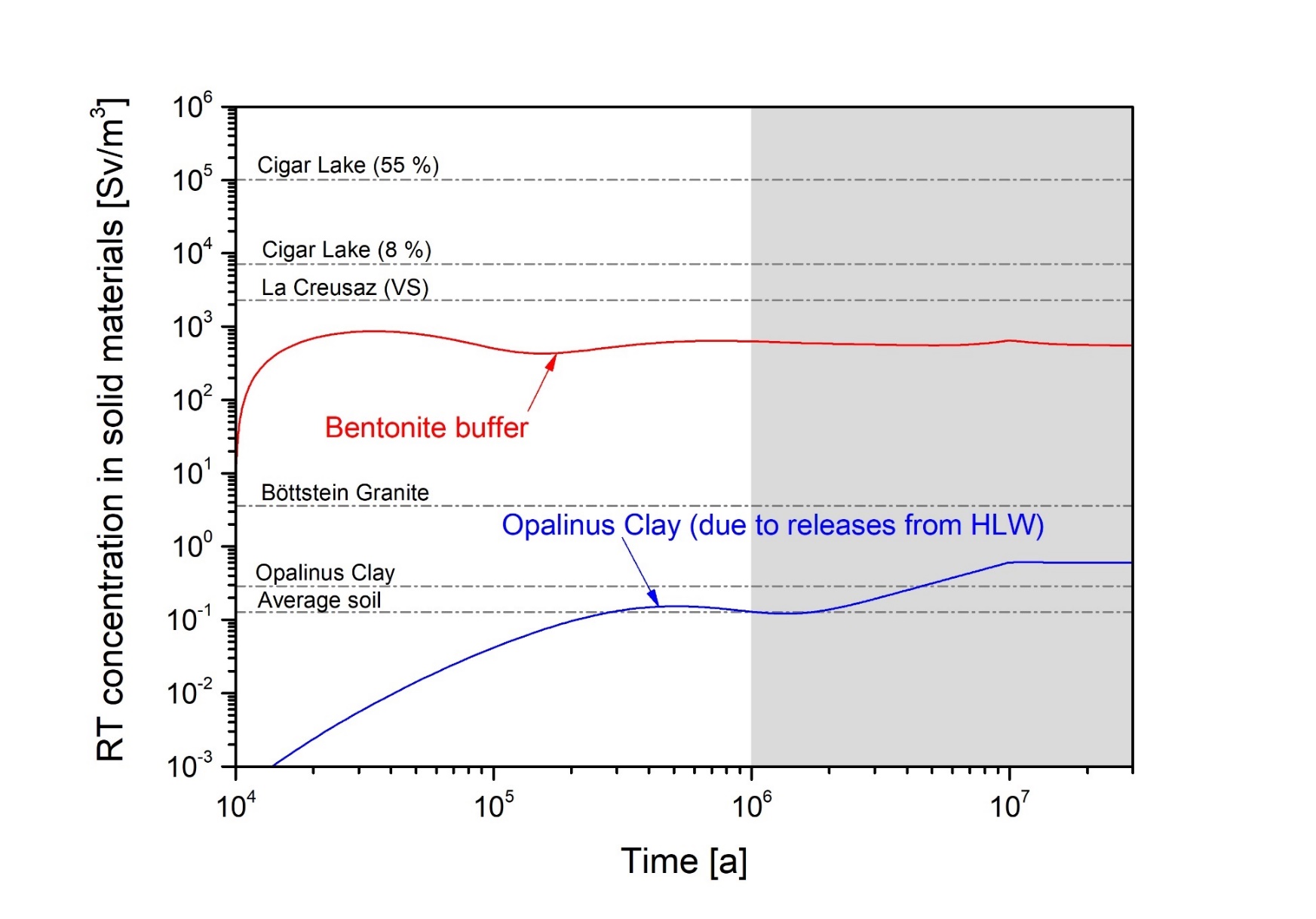
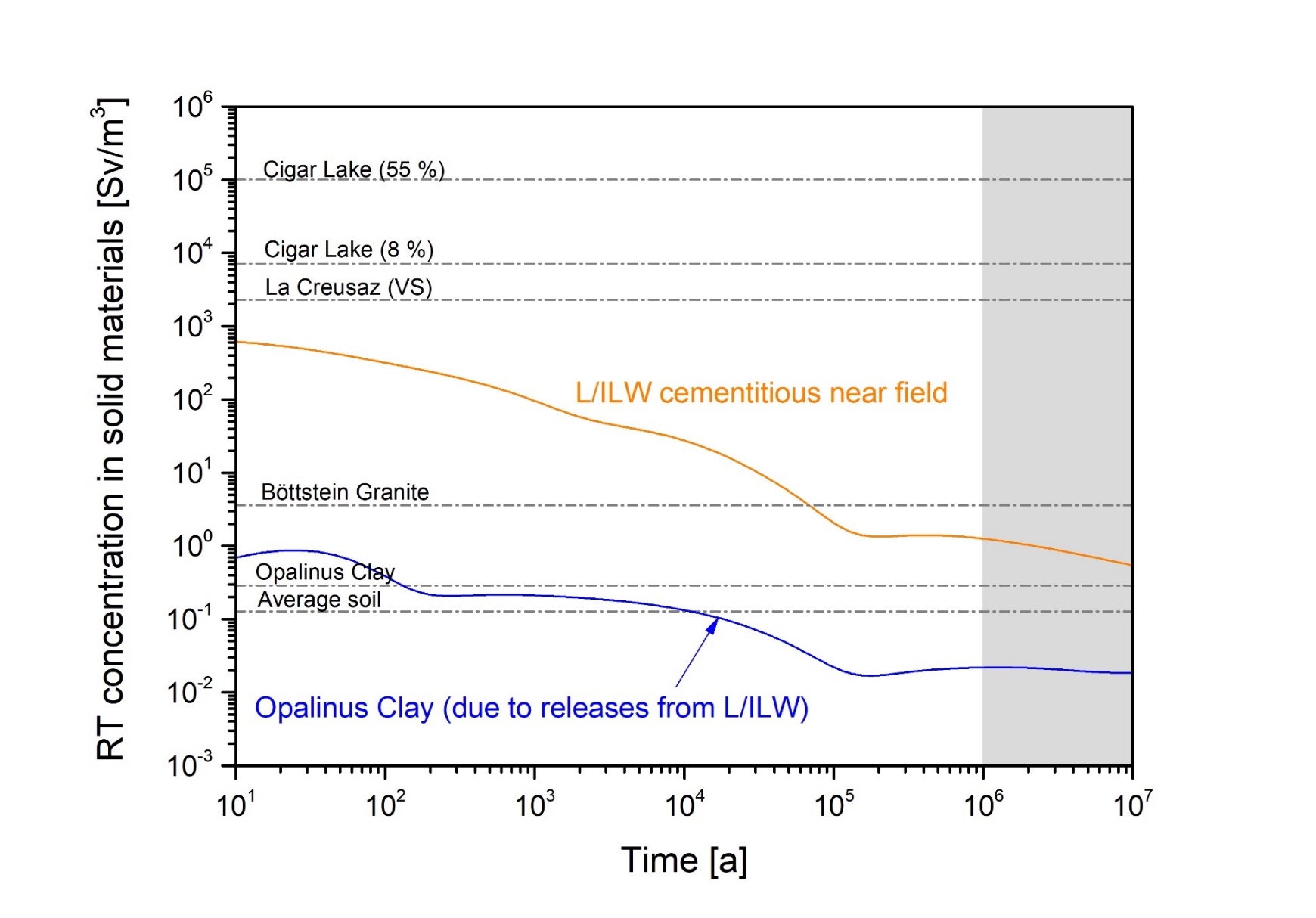
Fig. 9‑9:Reference case RT concentrations, sorbed and aqueous, in materials in the HLW bentonite buffer and in the L/ILW cementitious near field, as well as in the Opalinus Clay host rock, due to releases from HLW (upper figure) and from L/ILW (lower figure)
These concentrations are compared with the RT concentrations found naturally in various rocks and ores, including the Opalinus Clay, and in average soil.
The models used to calculate doses in the analysis of radiological consequences, as well as to evaluate the RT, RT fluxes and RT concentrations described in the previous sections, incorporate numerous conservative assumptions and simplifications to handle uncertainties that are not addressed by other means (e.g., through parameter variations).
Conservatisms include the deliberate omission of some phenomena that are considered likely to occur and that are beneficial to safety, from quantitative analysis because suitable models, codes, or databases are unavailable. Such phenomena are termed reserve FEPs, since they can be mobilised at a later stage of the waste disposal programme, provided the necessary models, codes, and databases are developed. Important reserve FEPs identified in the course of the Project Entsorgungsnachweis (Section 8.2.8.3 of NTB 02-05, Nagra 2002) that remain reserve FEPs in the present safety assessment are:
-
the co-precipitation of radionuclides with secondary minerals derived from spent fuel, glass and canister corrosion (except for co-precipitation of radium, which is included in all cases),
-
sorption of radionuclides on canister corrosion products,
-
natural concentrations of isotopes in solution in bentonite porewater, which could further reduce the effective solubilities of some radionuclides,
-
irreversible sorption of radionuclides in the near field or in the geosphere (surface mineralisation),
-
long-term immobilisation processes (precipitation / co-precipitation) in the geosphere, and
-
the delayed release of radionuclides, due to the slow corrosion rate of L/ILW metallic materials (e.g., hulls and ends), as well as a period of complete containment by L/ILW steel drums and emplacement containers.
Newly identified reserve FEPs that concern radionuclide release and transport in the aqueous phase are:
-
the absence, for an extended period of time, of a continuous liquid phase connecting the L/LW cavern and the host rock, which would be needed for the release of radionuclides into the aqueous phase and further transport to the biosphere, and
-
the increased sorption of some radionuclides due to elevated temperatures of the geological environment.
In addition, newly identified reserve FEPs that concern repository-generated gas and radionuclide release and transport in the gas phase are:
-
the presence of microorganisms in the backfilled operations and construction tunnels that have the potential to reduce the hydrogen gas pressure to well below the hydrostatic pressure, and
-
the impact on corrosion and degradation rates of the very slow resaturation of the repository, resulting in a very slow exchange of the original atmosphere with repository-generated gas such as hydrogen and slow build-up of gas pressures.
These reserve FEPs have the potential, in the future, to provide additional quantitative contributions to the evaluated performance of the disposal system. One specific reserve FEP that was identified in the Entsorgungsnachweis27, but, due to site characterisation activities carried out in the intervening years, was mobilised in the present safety assessment, is:
-
retardation in the confining geological units of the Opalinus Clay host rock.
This reserve FEP was conservatively neglected in the reference conceptualisation of the geosphere in the radionuclide retention and transport calculations for the Entsorgungsnachweis, but is included in the present analysis of radiological consequences, which considers retention and transport through a broader CRZ.
Even when they are not mobilised, the presence of reserve FEPs constitutes, in effect, an additional qualitative argument for safety, since it indicates that the actual performance of the disposal system will, in reality, be more favourable than that evaluated in the analysis of assessment cases given in Chapter 8, or with more detail in Chapter 7 of NTB 24‑18 (Nagra 2024p).
In addition to the reserve FEPs, there are further reserves due to several simplifying pessimistic or conservative assumptions that had to be made for the quantitative analysis of some assessment cases because of the limitations of the available models and codes as well as uncertainty in the underlying scientific understanding. Conceptual assumptions and simplifications of the models used in the analysis of radiological consequences are described in Chapter 3 and Appendix of NTB 24‑18 (Nagra 2024p). Many of those that are currently highly conservative are expected to be replaced by more realistic assumptions in future safety assessments, which will yield even lower calculated radiological consequences than in the present assessment.
Retardation in the confining geological units was only taken into account in a few calculations’ cases, due to limited data on the confining geological units that was available at the time. ↩
